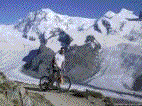Home :: India-Adventure Tourss :: Mountain Biking
MOUNTAIN BIKING
Human beings have made use of the wheel since ancient times. The invention of the wheel not only brought about a revolution in the realm of transportation but also gave rise to a number of sporting activities. Through the centuries, the wheel remained a faithful companion of man in both war and peace.

Mountain Biking |
Three- and four-wheeled horse-drawn carriages became popular mode of transport during the medieval period. Though horse-drawn carriages could transport a number of people from one place to another, there was a need to create a vehicle, which could be powered by human muscle and was easy to handle. The first "bicycle" was invented in the early years of the 19th century; however, it was nothing more than a "wooden horse". This strange-looking two-wheeled vehicle was also referred to as celeriferes and velociferes. The rider had to sit on the "wooden horse" and push his feet backward along the ground, to propel the vehicle forward. In the process of moving forward, the rider had to keep his balance. In 1817, Baron Karl von Drais built a model with a handlebar attached to the front wheel. The handlebar helped the rider to maintain balance, without having to touch the ground too often. |
Between 1817 and 1900 a number of developments like steel tubes, ball bearings, stable handlebars, pedals, chain, wire spokes, pneumatic tires, etc., improved the bike. At the beginning of the 20th century, bicycles became lighter, faster, comfortable and easier to handle. The low cost of maintenance made bicycle the most popular means of transport in the world. Bicycles were also used in great numbers during the World War II. In the course of time, people not only used bicycles for transportation but also for sporting activities, which included short- and long-distance races. Better and lighter models of bicycles were made for traversing hilly countryside and steep mountain roads. The sport of mountain biking has gained a lot of popularity amongst adventure seekers in countries having hilly tracts and mountain ranges.
India has some of the highest mountain ranges in the world. It also has some of the world's highest roads. Mountain biking amongst the majestic backdrop of the great Himalayan ranges is an unforgettable and thrilling experience.
Mountain biking is a land-based adventure sport.
LEVEL OF DIFFICULTY
Mountain biking in the foothills and hillocks across the countryside is relatively easier and less demanding than biking on high altitudes. The level of difficulty generally rises with increase in altitude. However, apart from the altitude, a number of factors determine the level of difficulty of a particular trail: distance to be covered, obstacles faced, inhospitable stretches, steep inclines, forest tracts, etc.
Short-distance trails can be covered in a day or two, while long-distance trails can be covered in a matter of days or a couple of weeks. Long-distance trails usually take you through different terrain and test your physical and mental endurance level to the limits.
PHYSICAL REQUIREMENTS
If you are interested in enjoying the thrills offered by biking in the midst of high mountain ranges, you must be physically fit, as mountain biking is a high endurance activity. There is no special or prescribed physical requirement for a person interested in taking up the sport of mountain biking but expectant mothers and people suffering from high blood pressure and heart problems must stay away from it. Even if you are physically fit for embarking on a mountain biking trail, make sure that you are acclimatized to the local climatic conditions before starting.
NECESSARY EQUIPMENTS
A mountain bike is a sophisticated vehicle and you will need to carry necessary equipment for ensuring a safe and comfortable ride. Apart from your mountain bike you will have to carry the following: Biking shoes, bike helmet, insulated gloves/waterproof gloves, cycling bags to carry essential material or your belongings, Lightweight, washable, insulated sports bottles for keeping beverages cool, collapsible water bags, first aid kit for long trails, sunglasses, insect/bug repellents and sunscreen lotions.
For maintenance and repair you must carry a cycle repair kit, which will have, lubes, non-toxic, water-soluble degreaser, grease tubes for greasing bearings and an aero spray for bike cleaning.
You must also carry a bike pump and a tool kit apart from spare tires. Accessories like speedometer, bike rack for carrying 90 lb (40 kg) weight, batteries, instruction manuals, maps and flashlights can also be used on long trails.
You must select suitable clothing or thermal wear to provide protection from the elements, while enjoying high-altitude mountain biking.
You can either carry all the necessary equipment for mountain biking or take the services of a backup van/jeep to carry your belongings and spares.
You will find it extremely difficult to obtain the necessary equipment for mountain biking from local markets and will have to import specially designed mountain bikes, equipment, spares and accessories from abroad.
MAJOR DESTINATIONS
Mountain biking as an adventurous activity is new to India. However, the country offers some of the most challenging mountain biking trails in the world. The famous mountain biking trails in India are discussed below.
The Leh-Manali Highway is the second highest motorable road in the world. It winds its way through some of the most hostile terrains. The entire stretch of 485 km (301 miles) between Leh and Manali offers a challenge to mountain bikers who have the opportunity to cut across the majestic Himalayan ranges through four mountain passes. This highway reaches a height of 5,328 m (17,480 ft) at Taglang La pass. The other three passes along the highway are the Lachlung La, the Baralacha La and the Rohtang pass. You will have to push your endurance to the limits to accept the challenge offered by this dangerous high-altitude trail. In spite of all the dangers involved, the Leh-Manali highway rewards you with spectacular and picturesque landscapes. |

Mountain Biking |
You can enjoy the beauty of the Ladakh plateau as you commence your journey from Leh towards Manali. The first halt is at Upshi, which is located at a distance of 49 km from Leh. The Taglang La pass is 109 km from Leh and is the next halt from Upshi. There are a number of camping spots along the highway between Upshi and Taglang La pass. The Leh-Manali highway suddenly evens out from this pass and enters the Morey plain. The descend continues until you reach Pang (184 km from Leh). The stretch of road just before Pang traverses a series of magnificent gorges. Pang is a tent settlement where you can rest for the night before resuming your journey. After leaving Pang, you will reach the Lachlung La pass, which is 209 km from Leh and is the second highest pass (5,060 m/16,601 ft) along the Leh-Manali highway. You will encounter some hair-raising bends along this road between Lachlung La pass and Sarchu (263 km from Leh).
Like Pang, Sarchu is also a tent settlement and a good place to stop over and stretch your limbs. Sarchu is located in the Indian state of Himachal Pradesh. From Sarchu you will climb to the Baralacha La pass (4883 m; 16020 ft), located at a distance of 299 km from Leh. You can also stop and relax at Darcha (340 km from Leh), which is located in between the Baralacha La pass, and the town of Keylong (372 km from Leh). Keylong is the first major town on the Leh-Manali highway and is near Tandi (380 km from Leh). Tandi is a located on a T-junction from where the highway turns southeast towards Manali. Between Tandi and Rohtang pass (the 4th and the last pass along the Leh-Manali highway), you will have to pass through Gondla (390 km from Leh), Sissu (398 km from Leh), Khoksar (414 km from Leh) and Gramphu (419 km from Leh). Rohtang pass is located at a height of 3978 m (13051 ft) and is located at a distance of 434 km from Leh. After crossing the Rohtang pass, you can reach Manali (485 km from Leh), which is the final destination of this adventurous journey.
Apart from the Leh-Manali highway, you can enjoy the thrilling experience of mountain biking in the foothills of the Himalayan ranges in and around the towns of Haridwar, Rishikesh, Dehradun and Mussoorie (all in the state of Uttar Pradesh). You can also go for mountain biking in Kullu and Manali (in Himachal Pradesh). The foothills of the eastern Himalayas in Sikkim, Darjeeling and Kalimpong also offer a number of short- and long-distance mountain biking trails.
BEST TIME
The best time for mountain biking in India is between the months of June to September, when mountain roads are open to traffic. In some parts of India, you can enjoy the experience of mountain biking between March and June. It is advised not to take part in mountain biking in the rainy season when the mountainous roads become slippery.
THE PROCESS
As soon as you choose a particular trail, the process of mountain biking begins. Make sure that your bike is in perfect shape, after it has traveled with you to the point of starting the journey. Thoroughly inspect your bike and make the necessary repairs. Before you start, take all the items you would require on the way and plan your adventure. Planning your trip not only helps you to stay focused but also helps you to achieve your day-to-day targets.
Keep your cool as you go mountain biking, as this activity will test both your physical and mental levels of endurance to the limit. While peddling away to glory, take time to enjoy the picturesque surroundings.
RESOURCES
The Ministry of Home Affairs, Government of India is the apex body responsible for granting permits to the restricted zones. Most of the Indian missions abroad are also authorized to grant such permits. Apart from these two, the foreigners' regional registration offices (FRROs) in Delhi, Mumbai, Chennai, Calcutta, and Amritsar can also grant these permits. The officials of the state governments are also authorized to grant permits.
PRECAUTIONS
1. Wear proper clothing for protection from cold winds.
2. Make proper arrangements for camping along the trail route.
3. Make repairs whenever needed.



